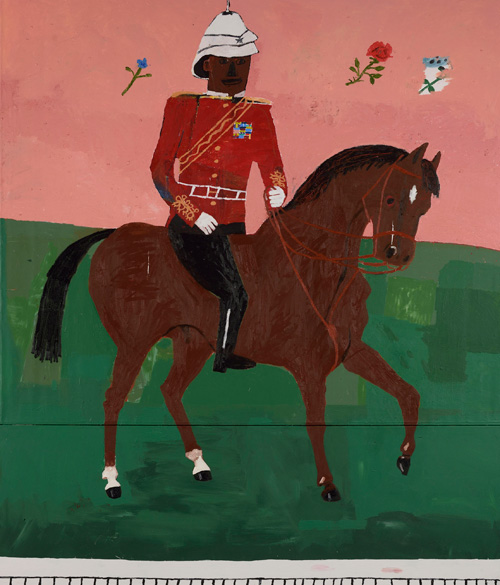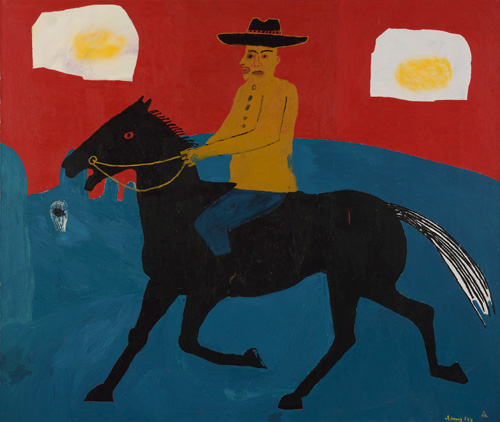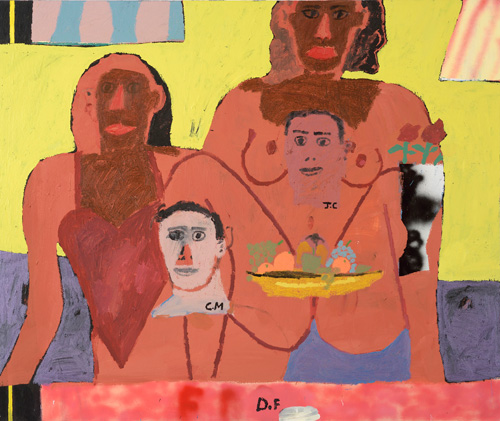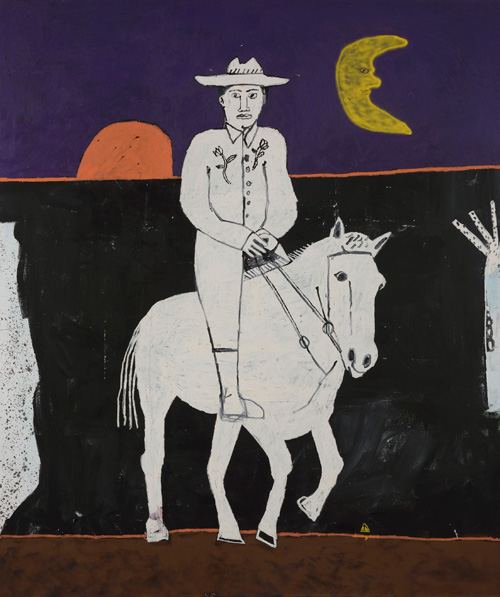
Danny Fox painting at Tim Noble and Sue Webster's studio in London, 2015. Photograph: Jack Whitefield.
by JESSICA DRAPER
For the past six months, Danny Fox (b1986) has been renting an impressive studio space in East London from the British artists Tim Noble and Sue Webster. Accessed through a side garage door, the spacious studio houses Fox’s largest paintings to date. Book covers form his paint palettes and a series of canvases are rolled up on the floor.
Fox’s third solo show, As He Bowed His Head To Drink, opens at the Redfern Gallery, London, on 17 November. It is a departure from his last solo show at the Cock ’n’ Bull Gallery in 2014 and from the DIY East London-style exhibitions he has previously shown in, and Fox is looking forward to it. The gallery, he says, is “one of the oldest and has been there since 1923”. He has kept an element of the DIY: for the opening night, he intends to serve Cornish ice-cream from ceramic plates that he made himself.

Danny Fox. As He Bowed His Head to Drink, 2015. Oil on canvas, 330 x 285 cm.
His work explores the theme of ritual, whether in a boxing match, the White Horse pub or in love, and he paints different outcomes on one canvas, creating a kaleidoscope of narratives. His style evokes the playfulness of early Parisian modernists and yet there is a cultural seriousness in his colourful canvases, underscored by hooky titles. There is duplicity in each painting that traces the relationship between violence and defeat, and he successfully represents the process of decision-making in his layered canvases. Fatal Decision shows a man with one body and two heads; half looks straight at you, the other half looks ahead with his teeth exposed. Inspired by Richard Simkin’s watercolours, Fox made these paintings while splitting his time between Los Angeles, St Ives, where he was born, and London, and he suggests that the image of a man on a horse is representative of change.
Jessica Draper: How do you work?
Danny Fox: I usually get in at 11 in the morning and leave around 7pm. If I’m on a roll, I stay until 10. It’s not a really long day, but I’m moving these big paintings around all day, working on this scale makes it a long day. It is beginning to fuck me up. I think I’ve got exhaustion or something. This show has been physically demanding to make; mentally, also. I’m going to go abroad for a while after this, and this is the next show [he gestures to some rolled canvases] ready to go. After this show, I don’t want to be left with no work, so these are for a New York show next year.
JD: Do you make sketches?
DF: I made a lot of sketches for this show. Because the paintings are so big, I didn’t want to waste so much paint, so I used the sketches for planning. I’ve got a big pile building up now, all on the same size paper, so it looks nice as a stack. Drawing is so important – my whole approach to my work can change in a single drawing. It’s happened a few times. I will just be doodling, then something happens that excites me and then I can take that on to the canvas.
JD: Tell me about the title of the show?
DF: As He Bowed His Head To Drink just came to me one night out of the air. I wanted to call it something that sounded beautiful, but at the same time hard. It could be about a horse bowing its head to drink from a stream, or it could be about a man bowing his head to his pint in the pub. I’m 30 next year. I’ve been drinking heavily on a very regular basis since I was 15, but now it feels like it’s over. And I don’t know what to do; I don’t know how to handle it, how to move forward, or how to behave. So it’s like a submission, bowing my head in defeat, respectfully.

Danny Fox. Fatal Decision, 2015. Oil on canvas, 240 x 285 cm.
JD: Because the White Horses show at the Cock ’n’ Bull Gallery in 2014 was also about a pub?
DF: Yeah, British pub culture, British culture, which obviously involves drinking. The horse paintings are about change. This one [he points to a painting] is called Fatal Decision, and you can see he is in two minds and he is riding from a sunrise to a sunset, or a sunset to the same sunset, do you know what I mean? An early working title for it was Don’t Wake Up Under The Same Sun, because that is what I felt like I was trying to do by doing these residencies [at the Sang Bleu in Los Angeles and Patrick Heron’s studio in Cornwall]. You think if you get away to another place, the same habits won’t follow you but, of course, they do, and we all have to wake up under the same sun. A lot of that is being in London and trying to stop drinking. I went to Cornwall to make these for five months. This one [he points to another painting] is called Return from Exile, so it’s all about change, I suppose, or trying to change. I simplified the work a lot there: these paintings are less built-up, with more conviction.
JD: You went home to get some space?
DF: It was going home, but I didn’t treat it like going home. I treated it like going somewhere unknown. I was going into exile. I was very young when I moved away from Cornwall. When I went back, I didn’t really socialise because all my friends had moved away long ago. So I had space in that sense, but also in the studio. I was renting Patrick Heron’s old studio in St Ives, which is really big. I was only supposed to go for two months, but ended up staying for five. If they had let me keep that studio, I would have stayed for ever, but they didn’t, so I went to LA.
JD: And moving to America is next?
DF: I need to get away. I feel the need to be quite isolated. In those two months in LA, I made a lot of paintings. I had a massive studio in LA for cheap – actually for nothing. It was a residency with a magazine/gallery called Sang Bleu. I just had a blow-up mattress in the corner of this huge warehouse downtown. I like it there, but I don’t know about living there. They say the water is running out and that’s the way it seems. I went out to Slab City [an off-grid community in the Californian desert, where people camp in recreational vehicles and trailers], and thought about moving there for a minute, but then decided to get the fuck out of there.
JD: I have been thinking about art’s role in society. William Hogarth used the print Gin Lane to try to tell people to drink less. Do you think of your paintings as being a social commentary?
DF: Not really, I keep it slightly more personal than that, I think. It is more of a personal commentary, but I do see myself as part of British culture: maybe I’m on his beer street. I mean, I don’t think I’m satirical like that. The painting I did of pubs didn’t have an opinion on what people should be doing. The painting Jumbo’s Clown Room, which I did in LA, depicts a famous strip club there that I was going to. I was angry at the time because the two gallerists I was working with wouldn’t pick up their phones for weeks on end, so I put them into the strip club scene, made them the lunchtime perverts. So, yes, commentary, but more personal.

Danny Fox. Jumbos Clown Room, 2015. Oil on canvas, 155 x 182 cm.
JD: Do you feel as if you make pictures for yourself more than for other people?
DF: Yes, they are more for myself. It’s easier to do it for yourself. I am mostly concerned with making a good picture. That is my biggest concern. It is not necessary to think about who it is for. I like to think if it’s good for me, it will be good for everyone.
JD: What makes a good picture to you? Do you prioritise narrative, form or palette?
DF: All that stuff needs to work before I start telling everyone they are drinking too much gin, or whatever. Especially as I am moving into this abstract thing, there is only so long you can think. In a painting, there is no narrative without form. This is the language you are using to narrate.
JD: I read that you paint from dreams. Are your pictures still from dreams or are they from historical events?
DF: Dreams, did I say that?
JD: I read it somewhere.
DF: Well, for that big one, As He Bowed His Head To Drink, I used a military drawing. I was inspired by a series by Richard Simkin. He painted watercolours just for military purposes, and I don’t know if they were meant to be art or not, but they were. That is kind of taken from that image. And these images are from drawing and drawing and drawing men on horses; they’re not from anything. It was the uniform at first, the redcoat used by the British army from the mid-17th century to the 19th century. They used them until they realised they were just targets for the enemy to see easily. Colonialism has been a great interest. Painting your interests might be wrong, I don’t know – your interests become your dreams. Sometimes, I have this dream and I’m young again and, in my dream, I know I have to paint all these paintings again. I think its related to the exhaustion. I’ve got these antique models of horses from my market days. I used to work on markets and sell antiques, and I picked up these horses. That is where my first ever horse pictures came from.
JD: Do you work on to the canvas in pencil first?
DF: No, I work straight on the canvas with paint. If I work with a pencil first, it gives the whole painting a feeling of uncertainty. I work in layers. I build the painting up over time, keeping the good, destroying the bad – or unnecessary.
JD: Frank Auerbach recently said that, when he paints, it “reanimates the past”. Do you feel that, when you paint, you engage with personal memories?
DF: It would be hard to not do that and be in the present. How do you get away from that [points to his head]? The goal in a painting sense is to be completely present without thinking. In a way, you are always thinking about those who have gone before you, and it is the hardest thing because everything has been done. To be honest, that is something I think about a lot, trying to be original. It’s always in the back of my mind, sometimes in the front of my mind.

Danny Fox. Return From Exile, 2015. Oil on canvas, 285 x 240 cm.
JD: You seem to engage with contemporary issues of urban life, but it still feels old.
DF: Well, horses could be considered an old subject, but what they represent to me is always a contemporary issue – man’s ambition to conquer and enslave.
JD: Do you want your work to be political?
DF: No, because I am so uncertain of politics.
JD: Uncertain?
DF: I don’t have a political stance. I’m just like any normal person concerned about the environment, but unable to stop consuming. I think about that a lot. Someone in politics needs to force everyone to be vegan. Even at a personal level, it needs to stop. It is ridiculous. I am a recent vegetarian and tried to be vegan straight away, but fucked up and ate cheese. I just felt bad. But you need somebody to force you to do it. Just ban meat. I made a painting about it. It’s called Beef.
JD: So your titles are quite important to you?
DF: Yes. If a work is titled well, it can really help people to see it in the way I do. I am interested in poetry. I’ve always written things down since I was young and I’m working on getting those writings together at the moment in a kind of poetry collection.
JD: Where do you see your paintings? In galleries, or homes, or houses? When you think of your work, where do you see it? In private collections or museums?
DF: Well, one can dream. When you make paintings that size, it takes a certain amount of ambition. I am an ambitious person and I want my paintings to be in museums, of course.
JD: Do you have a favourite gallery?
DF: I don’t like galleries, to be honest. I’ve got these black dots in my eyes, when I go into a white room, all I can see are these black dots everywhere. It’s like a real badly scratched camera lens. So it is uncomfortable. That is the fucking thing with all this shit though, I spend my whole life doing it and I go to an art gallery and I just feel sick. I spend my whole life for this thing and I don’t even enjoy the end thing of it. I feel very conflicted about that. Or like art shows, I hate them.
JD: I recently read an article about the future of art, galleries and museums. Olafur Eliasson suggested 24-hour museums, free to the public, where the guards in the room would be interested in the art. They would be more of a forum where people go to speak and sit, less sterile. In that way, paintings would once again become real conversation pieces between people – discussion pieces. Hogarth’s engravings were circulated to stimulate conversation. Would that interest you?
DF: My interest lies in the making of art. There are people out there who live to talk about the future of art and museums. I’m not one of them. I just like making it.
JD: Which artists do you look to and feel inspired by?
DF: Matisse, is a big inspiration. All my inspirations have come from books I’ve stumbled across in libraries. I like Bob Dylan a lot. I have been thinking about him recently. Like, where is Bob Dylan right now? What’s he up to? When I listen to his music, it inspires me to keep making, building up the body of work through all the phases. The imagery in a song like Sara is so killer. I want to hit that point with a painting.
JD: I read that you aren’t always interested in the names or movements, but just want to take things in. Do you still feel like that?
DF: Yeah, but you can’t help but learn and then you can’t unlearn. A couple of years ago, I was way more naive than I am now in terms of art names.
JD: Do you still enjoy London nightlife?
DF: Honestly, no.
JD: Does nightlife affect your work?
DF: Yeah, but less and less. Only in a negative way now. Everyone says that, as you get older, your hangovers get worse and worse. It’s true, you know. Those days of being inspired by a night out are gone for me. There is nothing I can see in a bar that inspires me. I’m over it. I feel like I’ve got every bit of inspiration there is from that world.
JD: Maybe when you go to America, you could sleep for a year?
DF: Yeah, it feels like that’s what I am going to do. I am going to the Tropics or Central America. I have got friends in the Tropics and they say it’s hard now. It is not all paradise. If you get sick, it’s a nightmare. But I want to go there. I just want to be warm.
• As He Bowed His Head To Drink is at the Redfern Gallery, 20 Cork Street, London W1, 17 November – 5 December 2015.